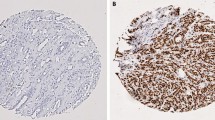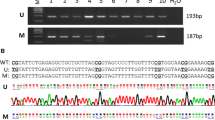Abstract
The study aims to identify the relevance of immunohistochemistry (IHC), copy number aberrations (CNA) and epigenetic disorders in BRCAness breast cancers (BCs). We studied 95 paraffin included BCs, of which 41 carried BRCA1/BRCA2 germline mutations and 54 were non hereditary (BRCAX/Sporadic). Samples were assessed for BRCA1ness and CNAs by Multiplex Ligation-dependent Probe Amplification (MLPA); promoter methylation (PM) was assessed by methylation-specific-MLPA and the expression of miR-4417, miR-423-3p, miR-590-5p and miR-187-3p by quantitative RT-PCR. IHC markers Ki67, ER, PR, HER2, CK5/6, EGFR and CK18 were detected with specific primary antibodies (DAKO, Denmark). BRCAness association with covariates was performed using multivariate binary logistic regression (stepwise backwards Wald option). BRCA1/2 mutational status (p = 0.027), large tumor size (p = 0.041) and advanced histological grade (p = 0.017) among clinic-pathological variables; ER (p < 0.001) among IHC markers; MYC (p < 0.001) among CNA; APC (p = 0.065), ATM (p = 0.014) and RASSF1 (p = 0.044) among PM; and miR-590-5p (p = 0.001), miR-4417 (p = 0.019) and miR-423 (p = 0.013) among microRNA expression, were the selected parameters significantly related with the BRCAness status. The logistic regression performed with all these parameters selected ER+ as linked with the lack of BRCAness (p = 0.001) and MYC CNA, APC PM and miR-590-5p expression with BRCAness (p = 0.014, 0.045 and 0.007, respectively). In conclusion, the parameters ER expression, APC PM, MYC CNA and miR-590-5p expression, allowed detection of most BRCAness BCs. The identification of BRCAness can help establish a personalized medicine addressed to predict the response to specific treatments.



Similar content being viewed by others
References
Lips EH, Mulder L, Oonk A, van der Kolk LE, Hogervorst FB, Imholz AL, Wesseling J, Rodenhuis S, Nederlof PM (2013) Triple-negative breast cancer: BRCAness and concordance of clinical features with BRCA1-mutation carriers. Br J Cancer 108(10):2172–2177. doi:10.1038/bjc.2013.144
Turner N, Tutt A, Ashworth A (2004) Hallmarks of ‘BRCAness’ in sporadic cancers. Nat Rev Cancer 4:814–819
Turner NC, Reis-Filho JS, Russell AM, Springall RJ, Ryder K, Steele D, Savage K, Gillett CE, Schmitt FC, Ashworth A, Tutt AN (2007) BRCA1 dysfunction in sporadic basal-like breast cancer. Oncogene 26(14):2126–2132
Lips EH, Mulder L, Hannemann J, Laddach N, Vrancken Peeters MTFD, van de Vijver MJ, Wesseling J, Nederlof PM, Rodenhuis S (2011) Indicators of homologous recombination deficiency in breast cancer and association with response to neoadjuvant chemotherapy. Ann Oncol 22:870–876
Vollebergh MA, Lips EH, Nederlof PM, Wessels LF, Schmidt MK, van Beers EH, Cornelissen S, Holtkamp M, Froklage FE, de Vries EG, Schrama JG, Wesseling J, van de Vijver MJ, van Tinteren H, de Bruin M, Hauptmann M, Rodenhuis S, Linn SC (2011) An aCGH classifier derived from BRCA1-mutated breast cancer and benefit of high-dose platinum-based chemotherapy in HER2-negative breast cancer patients. Ann Oncol 22(7):1561–1570
Chalasani P, Livingston R (2013) Differential chemotherapeutic sensitivity for breast tumors with “BRCAness”: a review. Oncologist 18(8):909–916
Akashi-Tanaka S, Watanabe C, Takamaru T, Kuwayama T, Ikeda M, Ohyama H, Mori M, Yoshida R, Hashimoto R, Terumasa S, Enokido K, Hirota Y, Okuyama H, Nakamura S (2015) BRCAness predicts resistance to taxane-containing regimens in triple negative breast cancer during neoadjuvant chemotherapy. Clin Breast Cancer 15(1):80–85
Lips EH, Laddach N, Savola SP, Vollebergh MA, Oonk AM, Imholz AL, Wessels LF, Wesseling J, Nederlof PM, Rodenhuis S (2011) Quantitative copy number analysis by Multiplex Ligation-dependent Probe Amplification (MLPA) of BRCA1-associated breast cancer regions identifies BRCAness. Breast Cancer Res 13(5):R107. doi:10.1186/bcr3049
Wessels LF, van Welsem T, Hart AA, van’t Veer LJ, Reinders MJ, Nederlof PM (2002) Molecular classification of breast carcinomas by comparative genomic hybridization: a specific somatic genetic profile for BRCA1 tumors. Cancer Res 62(23):7110–7117
Joosse SA, van Beers EH, Tielen IH, Horlings H, Peterse JL, Hoogerbrugge N, Ligtenberg MJ, Wessels LF, Axwijk P, Verhoef S, Hogervorst FB, Nederlof PM (2009) Prediction of BRCA1-association in hereditary non-BRCA1/2 breast carcinomas with array-CGH. Breast Cancer Res Treat 116(3):479–489
Schouten PC, Grigoriadis A, Kuilman T, Mirza H, Watkins JA, Cooke SA, van Dyk E, Severson TM, Rueda OM, Hoogstraat M, Verhagen CV, Natrajan R, Chin SF, Lips EH, Kruizinga J, Velds A, Nieuwland M, Kerkhoven RM, Krijgsman O, Vens C, Peeper D, Nederlof PM, Caldas C, Tutt AN, Wessels LF, Linn SC (2015) Robust BRCA1-like classification of copy number profiles of samples repeated across different datasets and platforms. Mol Oncol 9(7):1274–1286
Declaration of Human Rights, the Conference of Helsinki, http://www.wma.net/e/policy/pdf/17c.pdf
Gangul Ganguly A, Rock MJ, Prockop DJ (1993) Conformation-sensitive gel electrophoresis for rapid detection of single-base differences in double-stranded PCR products and DNA fragments: evidence for solvent-induced bends in DNA heteroduplexes. Proc Natl Acad Sci USA 90:10325–10329
de Juan I, Esteban E, Palanca S, Barragán E, Bolufer P (2009) High-resolution melting analysis for rapid screening of BRCA1 and BRCA2 Spanish mutations. Breast Cancer Res Treat 115(2):405–414
Esteban E, Bolufer P, Palanca S, Barragán E, Oltra S, Chirivella I, Segura A, Guillén C, Martínez E, Cuevas D, Salas D (2008) BRCA1 and BRCA2 mutations in families studied in the program of genetic counselling in cancer of the Valencian community (Spain). Med Clin (Barc) 130:121–126
Murria Estal R, Palanca Suela S, de Juan Jiménez I, Egoavil Rojas C, García-Casado Z, Juan Fita MJ, Sánchez Heras AB, Segura Huerta A, Chirivella González I, Sánchez-Izquierdo D, Llop García M, Barragán González E, Bolufer Gilabert P (2013) microRNA signatures in hereditary breast cancer. Breast Cancer Res Treat 142(1):19–30
Schouten JP, McElgunn CJ, Waaijer R, Zwijnenburg D, Diepvens F, Pals G (2002) Relative quantification of 40 nucleic acid sequences by multiplex ligation-dependent probe amplification. Nucleic Acids Res 30(12):e57
Nygren AOH, Ameziane N, Duarte HMB, Vijzelaar R, Waisfisz Q, Hess CJ, Schouten JP, Errami A (2005) Methylation-Specific MLPA (MS-MLPA): simultaneous detection of CpG methylation and copy number changes of up to 40 sequences. Nucleic Acids Res 33:e128
Henken FE, Wilting SM, Overmeer RM, van Rietschoten JGI, Nygren AOH, Errami A, Schouten JP, Meijer CJLM, Snijders PJF, Steenbergen RDM (2007) Sequential gene promoter methylation during HPV-induced cervical carcinogenesis. Br J Cancer 97(10):1457–1464
Bunyan DJ, Eccles DM, Sillibourne J, Wilkins E, Thomas NS, Shea-Simonds J, Duncan PJ, Curtis CE, Robinson DO, Harvey JF, Cross NC (2004) Dosage analysis of cancer predisposition genes by multiplex ligation-dependent probe amplification. Br J Cancer 91(6):1155–1159
Tibshirani RJ (2009) Univariate shrinkage in the Cox model for high dimensional data. Stat Appl Genet Mol Biol. doi:10.2202/1544-6115.1438
Sociedad Española de Hipertensión—Liga Española para la lucha contra la hipertensión arterial, http://www.seh-lelha.org/calcdiagnos.htm
Zweig MH, Campbell G (1993) Receiver-operating characteristic (ROC) plots: a fundamental evaluation tool in clinical medicine. Clin Chem 39(8):561–577
Palacios J, Robles-Frías MJ, Castilla MA, López-García MA, Benítez J (2008) The molecular pathology of hereditary breast cancer. Pathobiology 75(2):85–94
Rottenberg S, Jaspers JE, Kersbergen A, van der Burg E, Nygren AO, Zander SA, Derksen PW, de Bruin M, Zevenhoven J, Lau A, Boulter R, Cranston A, O’Connor MJ, Martin NM, Borst P, Jonkers J (2008) High sensitivity of BRCA1-deficient mammary tumors to the PARP inhibitor AZD2281 alone and in combination with platinum drugs. Proc Natl Acad Sci USA 105(44):17079–17084
Horiuchi D, Kusdra L, Huskey NE, Chandriani S, Lenburg ME, Gonzalez-Angulo AM, Creasman KJ, Bazarov AV, Smyth JW, Davis SE, Yaswen P, Mills GB, Esserman LJ, Goga A (2012) MYC pathway activation in triple-negative breast cancer is synthetic lethal with CDK inhibition. J Exp Med 209(4):679–696
Alles MC, Gardiner-Garden M, Nott DJ, Wang Y, Foekens JA, Sutherland RL, Musgrove EA, Ormandy CJ (2009) Meta-analysis and gene set enrichment relative to er status reveal elevated activity of MYC and E2F in the “basal” breast cancer subgroup. PLoS One 4(3):e4710. doi:10.1371/journal.pone.0004710
Chandriani S, Frengen E, Cowling VH, Pendergrass SA, Perou CM, Whitfield ML, Cole MD (2009) A core MYC gene expression signature is prominent in basal-like breast cancer but only partially overlaps the core serum response. PLoS One 4(8):e6693. doi:10.1371/journal.pone.0006693
Grushko TA, Dignam JJ, Das S, Blackwood AM, Perou CM, Ridderstråle KK, Anderson KN, Wei MJ, Adams AJ, Hagos FG, Sveen L, Lynch HT, Weber BL, Olopade OI (2004) MYC is amplified in BRCA1-associated breast cancers. Clin Cancer Res 10(2):499–507
Xu J, Chen Y, Olopade OI (2010) MYC and breast cancer. Genes Cancer 1(6):629–640
Li Z, Owonikoko TK, Sun SY, Ramalingam SS, Doetsch PW, Xiao ZQ, Khuri FR, Curran WJ, Deng X (2012) c-Myc suppression of DNA double-strand break repair. Neoplasia 14:1190–1202
Virmani AK, Rathi A, Sathyanarayana UG, Padar A, Huang CX, Cunnigham HT, Farinas AJ, Milchgrub S, Euhus DM, Gilcrease M, Herman J, Minna JD, Gazdar AF (2001) Aberrant methylation of the adenomatous polyposis coli (APC) gene promoter 1A in breast and lung carcinomas. Clin Cancer Res 7(7):1998–2004
Collins N, Wooster R, Stratton MR (1997) Absence of methylation of CpG dinucleotides within the promoter of the breast cancer susceptibility gene BRCA2 in normal tissues and in breast and ovarian cancers. Br J Can 76(9):1150–1156
Welcsh PL, King MC (2001) BRCA1 and BRCA2 and the genetics of breast and ovarian cancer. Hum Mol Genet 10(7):705–713
Moelans CB, Anoek HJ, Verschuur-Mae J, van Diest P (2011) Frequent promoter hypermethylation of BRCA2, CDH13, MSH6, PAX5, PAX6 and WT1 in ductal carcinoma in situ and invasive breast cancer. J Pathol 225:222–231
Ben Gacem R, Hachana M, Ziadi S et al (2012) Contribution of epigenetic alteration of BRCA1 and BRCA2 genes in breast carcinomas in Tunisian patients. Cancer Epidemiol 36(2):190–197
Stein RA, McDonnell DP (2006) Estrogen-related receptor alpha as a therapeutic target in cancer. Endocr Relat Cancer 13(Suppl 1):S25–S32
Paraskevopoulou MD, Georgakilas G, Kostoulas N, Vlachos IS, Vergoulis T, Reczko M, Filippidis C, Dalamagas T, Hatzigeorgiou AG (2013) DIANA-microT web server v5.0: service integration into miRNA functional analysis workflows. Nucleic Acids Res 41:W169–W173
Acknowledgments
We would like to thank to the Carlos III Health Institute for having granted the Project PI10/00347. We also would like to thank to the Health Research Institute La Fe for having granted Rosa Murria Estal which made possible her participation in the study. We should thank the effort to perform this work to the pathologists Ana García Martínez (University Hospital La Fe) and Francisco Javier Seguí Ivañez (University Hospital of Alicante), to the laboratory technician Estefania Rojas Calvente (University Hospital of Alicante), to David Hervás statistician of the Health Research Institute La Fe and to Jacobo Martinez Santamaría, Mercedes Goicoechea Sáez and Dolores Salas Trejo (General department of public health, Conselleria de Sanitat, Generalitat Valenciana). Finally we would like to acknowledge the patients enrolled in this study and the Biobank of the General University Hospital of Alicante and the biobank for the biomedical research and public health of the Comunidad Valenciana (IBSP-CV) as part of the Valenciana Biobank Network (RVB) and the National Biobank.
Author information
Authors and Affiliations
Corresponding author
Ethics declarations
Conflict of interest
The authors declare that they have no conflict of interest.
Electronic supplementary material
Below is the link to the electronic supplementary material.
Rights and permissions
About this article
Cite this article
Murria Estal, R., Palanca Suela, S., de Juan Jiménez, I. et al. Relationship of immunohistochemistry, copy number aberrations and epigenetic disorders with BRCAness pattern in hereditary and sporadic breast cancer. Familial Cancer 15, 193–200 (2016). https://doi.org/10.1007/s10689-015-9864-2
Published:
Issue Date:
DOI: https://doi.org/10.1007/s10689-015-9864-2




